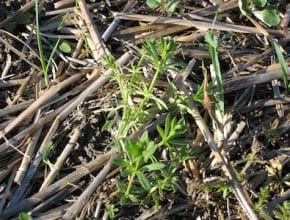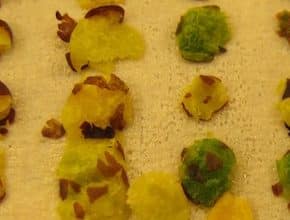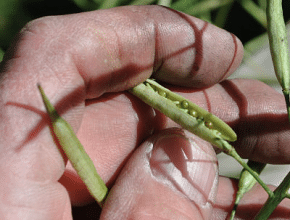High green seed counts have been reported in some fields. To restart the chlorophyll-clearing enzymes, canola seed needs to get back above 20% moisture. Reasonably warm temperatures, ideally at least 15 C, are also needed. Frost is forecast for later this week. Any crops not in the swath already and that need more time to mature are probably best left…
September 12, 2012 - Issue 29
-
-
-
Cold temperatures help trigger winter annuals, such as cleavers (shown), and perennials to start moving food reserves down into below ground tissues, so waiting until after the cooler weather can improve weed control. But make sure weeds are actively growing with new supple leaf area to target, and that the actual spray day is warm…
-
Growers with dry canola and high green counts are wondering whether to leave the swathed crop a while longer or combine now and accept the grade loss. When making that decision, ask: Is moisture in the forecast? How green is it? What's the price discount? These and other considerations will help with the decision…
-
Canola with high chlorophyll content is less stable in storage, even if the canola is dry and cool. The safest bet is to deliver sooner than later. If that is not an option, proper conditioning and frequent monitoring for heating and spoilage are crucial until it can be delivered…
-
With light frost in the forecast, crop left standing will still have a chance to mature further. A heavy frost will lock in high green counts unless the crop has adequate dry down time to achieve a seed moisture of 20% or less. Swathing has to occur at least 3 good drying days before the frost to achieve this benefit…
-
Canola can usually withstand a light frost, and immature crops are best left standing to finish. However, check anyway. The crop may look undamaged that morning but by lunch time, wilting, desiccation and pod splitting may begin. If you scout early and then not again, you may underestimate the damage and miss a chance to swath now to save some…




